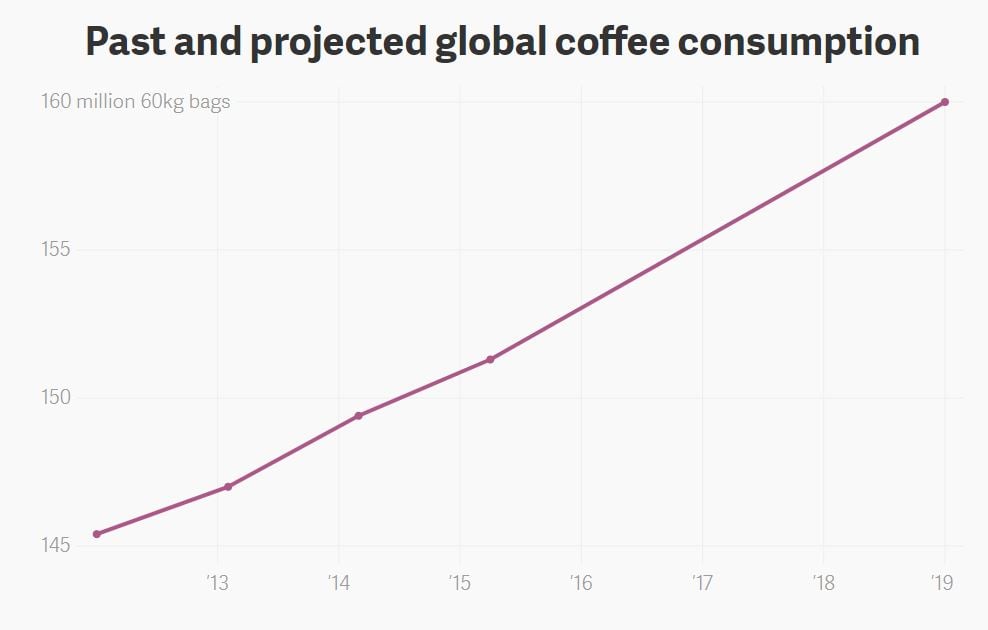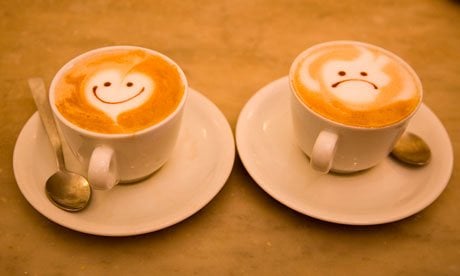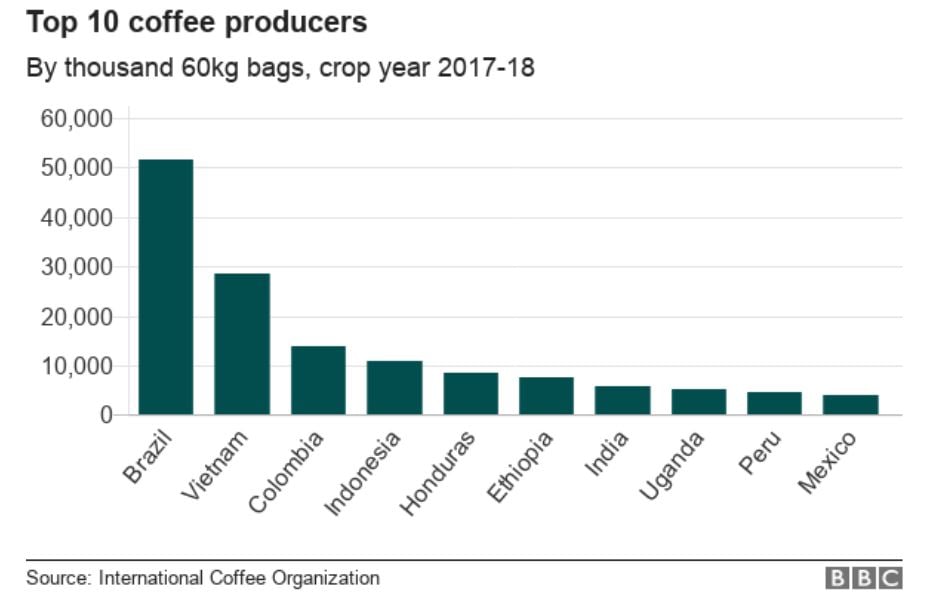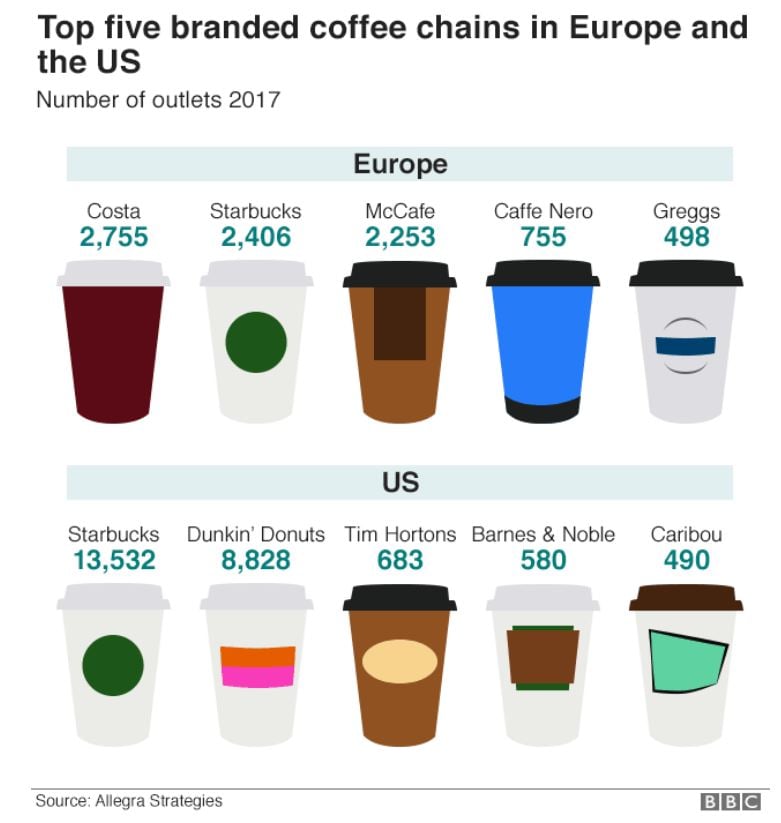
Many of us love our coffee, I know I do. Coffee is a high commodity; fluctuating in price every year and it’s the world’s second most tradable product, after oil. But it’s not just us coffee drinkers that depend on our daily cup, but globally 125 million people rely on the coffee industry for employment (according to fairtrade.com.au) and meeting the demand for growing beans and keeping 125 million people employed gets harder every year thanks to the ever-present threat of climate change for coffee farmers. Many farmers have already reported negative effects of changing weather patterns and increased pests. Howard Schultz, the former Chairman of Starbucks and former US Democratic Presidential candidate said that climate change is a long-term threat for Starbucks “climate change is going to play a bigger role in affecting the quality and integrity of coffee.” Source

This chart shows the demand for coffee over the last 6 years. Data source.
Climate change and it’s erratic and extreme weather patterns create droughts, diseases and insects, all of which can impact the quality and growth of coffee beans.
“About half of the land around the world currently used to produce high-quality coffee could be unproductive by 2050, according to a recent study in the journal Climatic Change. Another paper, in the journal Proceedings of the National Academy of Sciences, suggests that that number could be as high as 88% in Latin America.”
If demand continues to grow and bean production becomes affected we could start to see our price of coffee sky-rocket to become a luxury like Champagne.

image from Theguardian
Coffee’s effect on the environment
But, that’s the impact the environment has on coffee, what is the impact that coffee has on the environment? How fairly traded is your Fairtrade coffee?
Did you know that “on average, third world coffee farmers receive a paltry 10 per cent of the eventual retail price”? source
Originally coffee was grown in delicate eco-systems or tropical and subtropical areas with different floras that contribute to high diversity levels and shade that create habitable areas for indigenous animals and insects. The trees and animals helped to prevent topsoil erosion and prevented a need for fertilisers. As global demand for coffee has grown, so did the need for plantations and ‘sun cultivation’, removing the shady trees and animal habitats. These plantations that started in the 1970s have no shaded canopies and mean chemical fertilisers are now crucial. The removal of trees and impact of the sun degrade soil quality and lead to higher levels of erosion. It has led to the deforestation of 2.5 million acres of forest in Central America. The WWF has provided stats that of the 50 countries in the world with the highest deforestation rates, 37 of these are coffee producing.
Coffee processing plants often discharge waste into rivers creating pollution and contamination problems that can cause eutrophication of the water systems and kill aquatic plants and animals.
“Over a 6 month period in 1988, it was estimated that processing 547,000 tons of coffee in Central America generated as much as 1.1 million tons of pulp and polluted 110,000 cubic metres of water each day”. source

“These are the sorts of plantations that led to the coffee glut in Vietnam, and are currently expanding in China.” The Conversation
As coffee demand grows, so does the market and in come the new suppliers. For example, China and Nepal are expanding their coffee exportation.
Increased global demand and large retailers like Starbucks lead to complicated production and supply chains with little transparency. The impact on workers and the environment can be hard to measure.
This has led to a rise of Fairtrade coffee supply and demand from consumers like us for a more ethical cup of coffee. Fairtrade aims to reduce poverty with improved trade and minimum pricing regulations and a more stable market protected from fluctuations. It also gives farmers the opportunity to deal directly with large retailers like Starbucks instead of going through middle-men and offers additional programs like scholarships, healthcare and training.
“Fairtrade coffee means consumers can trace their coffee beans to find out exactly where they came from, and farmers are guaranteed a minimum price for their coffee. Fairtrade coffee farmers produce an estimated 560,900 tonnes of coffee a year – that’s enough to make more than 58.9 billion single espressos.” source
“Fairtrade is one of the most widely applied sustainable systems in the coffee marketplace and represents approximately 27 per cent of the overall market share.” source
However, Fairtrade does not address the environmental impacts of coffee growing. Sellers that want to grow their crop more sustainably and use this as a selling point can partner with the Rainforest Alliance who ensure a seller is conserving biodiversity, taking no part in deforestation and reforesting non-productive areas of farms. Kenco and Costa have both signed up to this program.
 Take away coffee cups add to the damage to the environment with 1 billion disposable coffee cups used in Australia alone, every year.
Take away coffee cups add to the damage to the environment with 1 billion disposable coffee cups used in Australia alone, every year.
Coffee has a large and increasing effect on the environment from start to finish and the best way we, as consumers, can reduce the impact on the environment, animal species and the farms producing the beans is to make informed decisions with our buying power. You can buy organic, carbon-negative and non-GM brands, but the best certifications to look out for are Fairtrade or Rainforest Alliance certified products. Always use a reusable coffee cup for your take away coffee orders and try and buy your coffee from local and smaller retailers – “As in most cases of consumer goods, the big brands are generally the least ethical and their coffee is likely leaving a trail of devastation in its wake.” source


